Adaptive Control of Energy Storage Systems for Real-Time Power Mediation Based on Energy on Demand System
Abstract
:1. Introduction
2. Research Problem
3. Demand-Based Mediation Algorithm for Intelligent Power Management
3.1. EoD Protocol
3.2. Preliminary Planning Phase
3.3. Implementation Phase
- When a home appliance changes its operation mode (i.e., ON/OFF), a power demand request message containing the actual power demand (required power) and appliance priority is issued from the home appliance and sent to the power manager.
- Upon receiving a request from appliance, the power manager mediates the power demand based on appliance priority, available power sources, and actual power demand given in the power demand request message. Based on the target power usage plan, the target power level for the home appliance is calculated, which is called allocated power. If the sum of consumed power of all current appliances (already turned ON) is less than the power usage plan, the power manager sends a power acceptance message and allows the home appliances that requested power to use the demanded power. In case the power usage plan is at capacity or exceeded, the power level of the home appliance with low priority would be reduced, or the power rejection/reduction message will be transmitted to these requested home appliances based on their priority.
- After receiving the power acceptance/allocation message, home appliances can use power specified by the power manager. If a power rejection is received by the appliance, it has to stop its operation for a while until the appliance sends a request message for power again to the EoD power manager.
3.4. Dynamic Priority Profile of Home Appliances
4. Proposed Method: Supply–Demand Based Mediation Algorithm
4.1. Problem Formulation
4.2. Preliminary Planning Phase
4.2.1. Create Initial Power Usage Plan
4.2.2. Create Power Supply Plan by Minimizing Dissatisfaction
4.3. Implementation Phase
4.3.1. Power Supply Characteristics and Conditions
4.3.2. Real-Time Power Mediation Process
4.3.3. Power Request Arbitration by Event-Driven Process
- Initialization:
- In order to satisfy the expression (17) for the new power request, the power supply from the power source with the lowest power load factor to the current power supply of each power source is increased by .
- Step-1:
- Select the home appliance with the lowest priority and the power source with the highest power load factor.
- Step-2:
- If is satisfied, then we terminate the mediation process because constraint (18) is satisfied.
- Step-3:
- Decrease supply to according to the controllability of home appliances described in [16] (by either turning it OFF, shifting the power request on standby, temporarily suspend operating home appliances, etc.). Let be the reduced power consumption for . Update the supplying power for and the required power for as follows.If is turned OFF or its operation is suspended, then its power request would be removed from the arbitrated home appliance A. If the power allocation is reduced, then the allocated power along with appliance priority are updated, and then, the procedure returns to Step 1.
4.3.4. Correction of Supply Plan by Periodic Start up Process
4.3.5. Maximum Instantaneous Power Monitoring by Constant Monitoring Process
5. Experimental Results
5.1. Experimental Environment
5.2. Experimental Results of Planning Phase
5.3. Experimental Results of Implementation Phase
5.4. Study on Peak Power Reduction Limitations
5.5. Comparison with Peak Cut Using Only Storage Battery
6. Conclusions
Author Contributions
Funding
Conflicts of Interest
Nomenclature
| Charge efficiency | |
| Discharge efficiency | |
| Maximum instantaneous power supply limitation from electric grid supply | |
| Maximum accumulated power supply limitations from electric grid supply | |
| Maximum power discharge limitation of storage battery | |
| Maximum power charge limitation of storage battery | |
| Capacity of the storage battery | |
| Power usage plan of power consumption at time t | |
| Power supply plan of electric grid at time t | |
| Power storage plan of storage battery at time t | |
| Initial power usage plan at time t | |
| Power allocated to requested home appliance a | |
| Priority of requested home appliance a | |
| Power supplied from requested supplier s | |
| A | Group of home appliances |
| Power demand of ath home appliance at time t | |
| Power supply pattern | |
| Power supply from electric grid at time t | |
| Power supply from storage battery at time t | |
| Accumulate power supply from electric grid at time t | |
| Accumulated power stored in storage battery at time t |
References
- Matsuyama, T. Creating safe, secure, and environment-friendly lifestyles through i-Energy. New Breeze 2009, 21, 1–8. [Google Scholar]
- Timotheee, C.; Perera, A.T.D.; Scartezzini, J.L.; Mauree, D. Optimum dispatch of a multi-storage and multi-energy hub with demand response and restricted grid interactions. Energy Procedia 2017, 142, 2864–2869. [Google Scholar] [CrossRef]
- Vatu, R.; Ceaki, O.; Porumb, R.; Seritan, G. Storage Optimization: Benefits brought by storage itself with an energy price minimization. In Proceedings of the 53rd International Universities Power Engineering Conference (UPEC), Glasgow, UK, 4–7 September 2018; pp. 1–6. [Google Scholar]
- Yang, T. The optimal capacity determination method of energy storage system with different applications in wind farm. In Proceedings of the IEEE PES Asia-Pacific Power and Energy Engineering Conference (APPEEC), Xi’an, China, 25–28 October 2016; pp. 2081–2085. [Google Scholar]
- Umer, S.; Tan, Y.; Lim, A.O. Stability analysis for smart homes energy management system with delay consideration. J. Clean Energy Technol. 2014, 2, 332–338. [Google Scholar] [CrossRef] [Green Version]
- Umer, S.; Tan, Y.; Lim, A.O. Priority based power sharing scheme for power consumption control in smart homes. Int. J. Smart Grid Clean Energy 2014, 3, 340–346. [Google Scholar] [CrossRef] [Green Version]
- Umer, S.; Kaneko, M.; Tan, Y.; Lim, A.O. System design and analysis for maximum consuming power control in smart house. J. Autom. Control Eng. (JOACE) 2014, 2, 43–48. [Google Scholar] [CrossRef] [Green Version]
- Mobious, T.; Gunkel, D. The optimal placing of energy storages in Germany in 2020 — An implementation of a DC-load flow model. In Proceedings of the 11th International Conference on the European Energy Market (EEM14), Cracow (Kraków), Poland, 28–30 May 2014. [Google Scholar]
- Javaid, S.; Kurose, Y.; Kato, T.; Matsuyama, T. Cooperative distributed control implementation of the power flow coloring over a Nano-grid with fluctuating power loads. IEEE Trans. Smart Grid 2017, 8, 342–352. [Google Scholar] [CrossRef]
- Javaid, S.; Kato, T.; Matsuyama, T. Power flow coloring system over a Nano-grid with fluctuating power sources and loads. IEEE Trans. Ind. Inform. 2017, 2017 13, 3174–3184. [Google Scholar] [CrossRef]
- Javaid, S.; Kaneko, M.; Tan, Y. Structural condition for controllable power flow system containing controllable and fluctuating power devices. Energies 2020, 13, 1627. [Google Scholar] [CrossRef] [Green Version]
- Javaid, S.; Kaneko, M.; Tan, Y. An efficient testing scheme for power balanceability of power system including controllable and fluctuating power devices. Designs 2020, 4, 48. [Google Scholar] [CrossRef]
- Javaid, S.; Kaneko, M.; Tan, Y. Safe operation conditions of electrical power system considering power balanceability among power generators, loads, and storage devices. Energies 2021, 14, 4460. [Google Scholar] [CrossRef]
- Javaid, S.; Kaneko, M.; Tan, Y. System condition for power balancing between fluctuating and controllable devices and optimizing storage sizes. Energies 2022, 15, 1055. [Google Scholar] [CrossRef]
- Kato, T.; Yuasa, K.; Matsuyama, T. Energy on demand: Efficient and versatile energy control system for home energy management. In Proceedings of the 2011 IEEE International Conference on Smart Grid Communications (SmartGridComm), Brussels, Belgium, 17–20 October 2011; pp. 410–415. [Google Scholar]
- Kato, T.; Yuasa, K.; Matsuyama. Energy on demand. IPSJ J. 2013, 54, 1185–1198. (In Japanese) [Google Scholar]
- Wang, Y.; Xiang, C.; Wang, W. Energy management strategy based on fuzzy logic for a new hybrid battery ultracapacitor energy storage system. In Proceedings of the IEEE Conference and Expo on Transportation Electrification Asia-Pacific (ITEC Asia-Pacific), Beijing, China, 31 August–3 September 2014. [Google Scholar]
- Wang, W.; Xue, J.; Ye, J. An optimization control design of battery energy storage based on SOC for leveling off the PV power fluctuation. Power Syst. Prot. Control 2014, 42, 75–80. [Google Scholar]
- Li, X.; Hui, D.; Lai, X. Battery energy storage station (BESS)-based smoothing control of photovoltaic (PV) and wind power generation fluctuations. IEEE Trans. Sustain. Energy 2013, 42, 464–473. [Google Scholar] [CrossRef]
- Sossan, F.; Torregrossa, D.; Namor, E. Control of a battery energy storage system accounting for the charge redistribution effect to dispatch the operation of a medium voltage feeder. IEEE Eindh. Powertech 2015, 1–6. [Google Scholar]
- Lin, Q.; Yin, M.; Shi, D. Optimal control of battery energy storage system integrated in PV station considering peak shaving. Chin. Autom. Congr. (CAC) 2017, 2750–2754. [Google Scholar]
- Zhao, H.; Wu, Q.; Wang, C. Fuzzy logic based coordinated control of battery energy storage system and dispatchable distributed generation for microgrid. J. Mod. Power Syst. Clean Energy 2015, 3, 422–428. [Google Scholar] [CrossRef] [Green Version]
- Bu, X.; Hou, Z.; Zhang, H. Data-driven multi agent systems consensus tracking using model free adaptive control. IEEE Trans. Neural Netw. Learn. Syst. 2017, 29, 1514–1524. [Google Scholar] [CrossRef] [PubMed]
- Kato, T.; Cho, H.-S.; Lee, D.; Toyomura, T.; Yamazaki, T. Appliance Recognition from Electric Current Signals for Information-Energy Integrated Network in Home Environments. Int. J. Assist. Robot. Syst. 2019, 10, 51–60. [Google Scholar]
- Matsuyama, T. i-Energy: Smart demand-side energy management, Chapter 8. In Smart Grid Applications and Developments; Springer: London, UK, 2014. [Google Scholar]
- Kato, T.; Cho, H.-S.; Lee, D.; Toyomura, T.; Yamazaki, T. Smart Apartment with an integrated Smart Tap Network. 2011. Available online: http://www.youtube.com/watch?v=QRQ72xtzDHE (accessed on 8 April 2018).
- Edagawa, T.; Fukae, K.; Hisakado, T. Peer-to peer energy transmission system by bidirectional AC-DC converter module. Inst. Elect. Eng. Jpn. 2014, 91–96. (In Japanese) [Google Scholar]

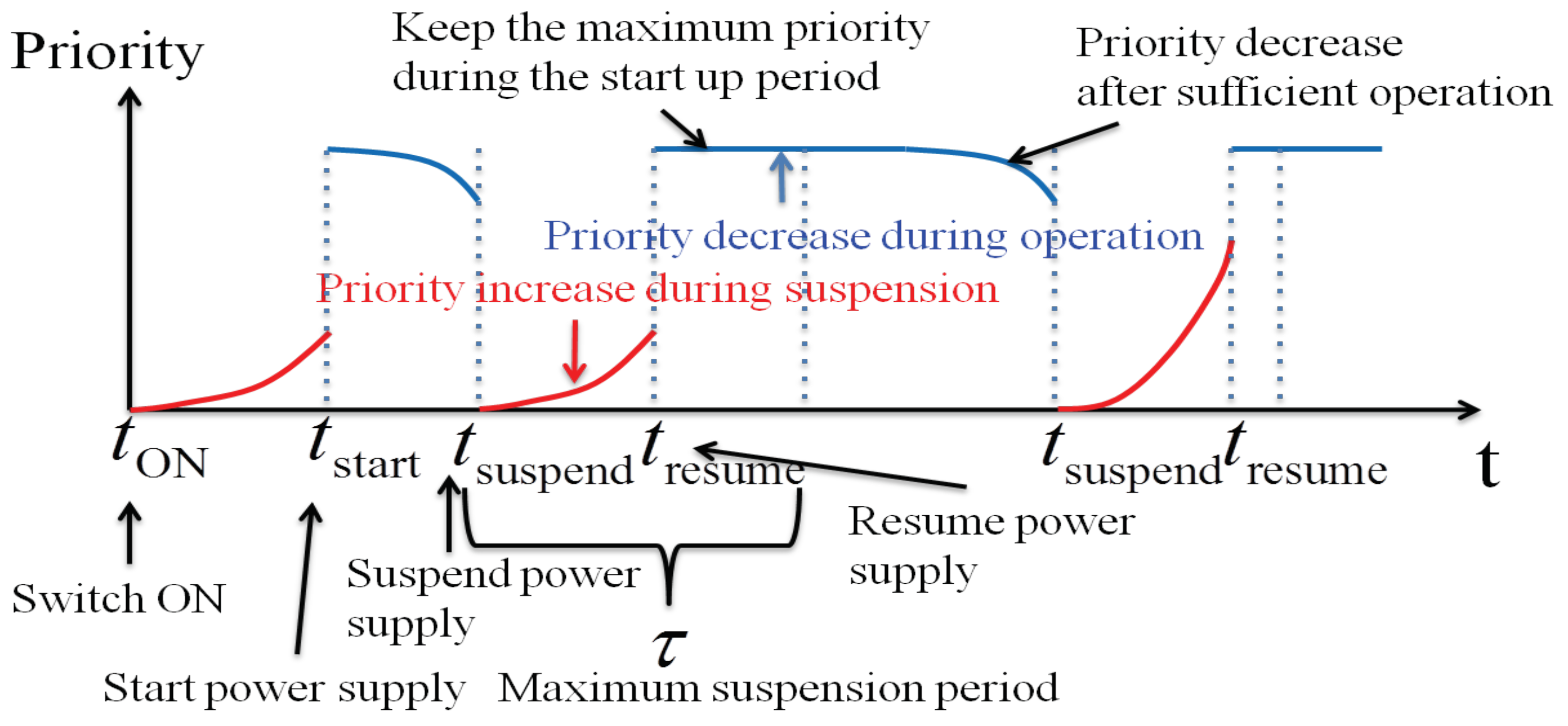

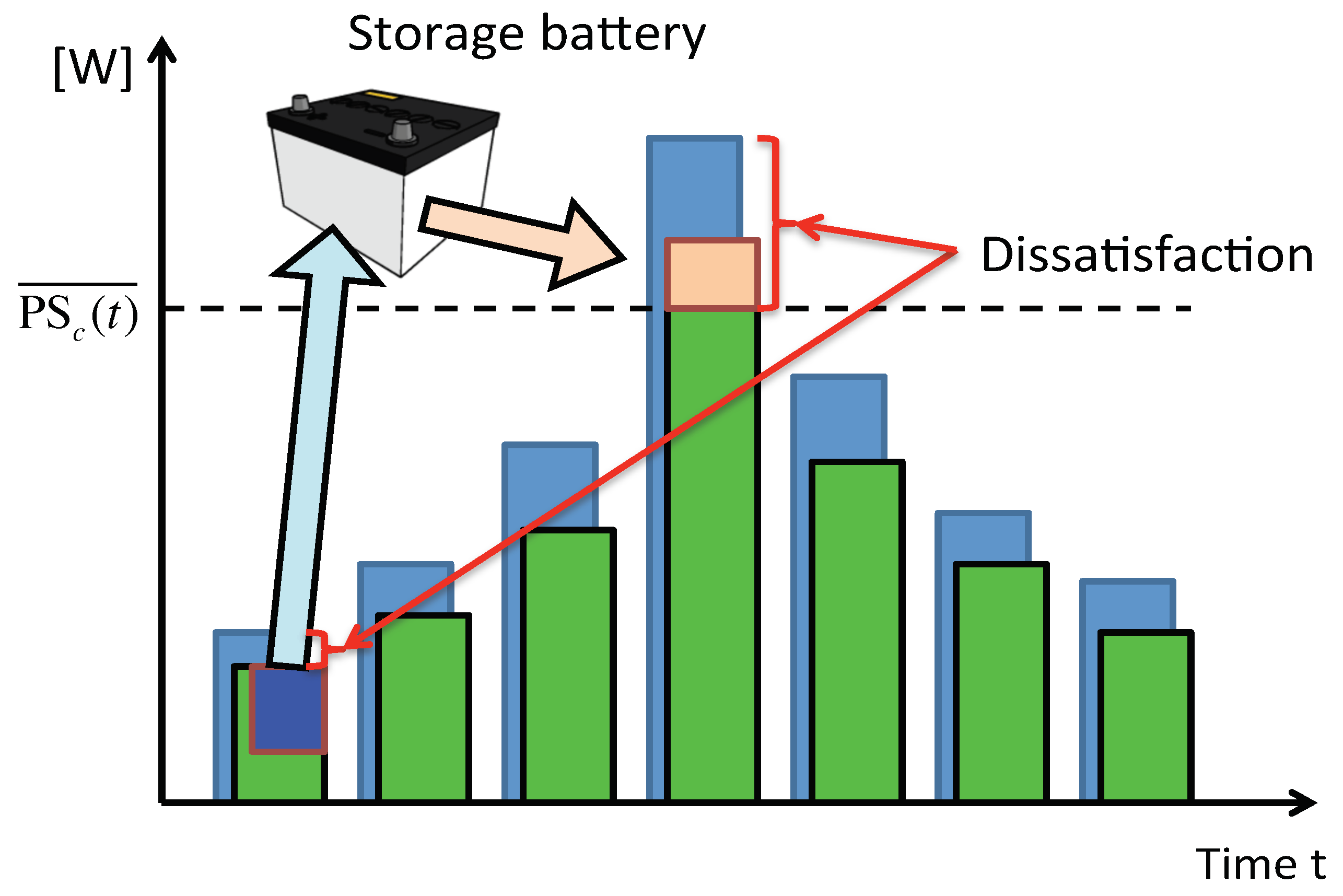
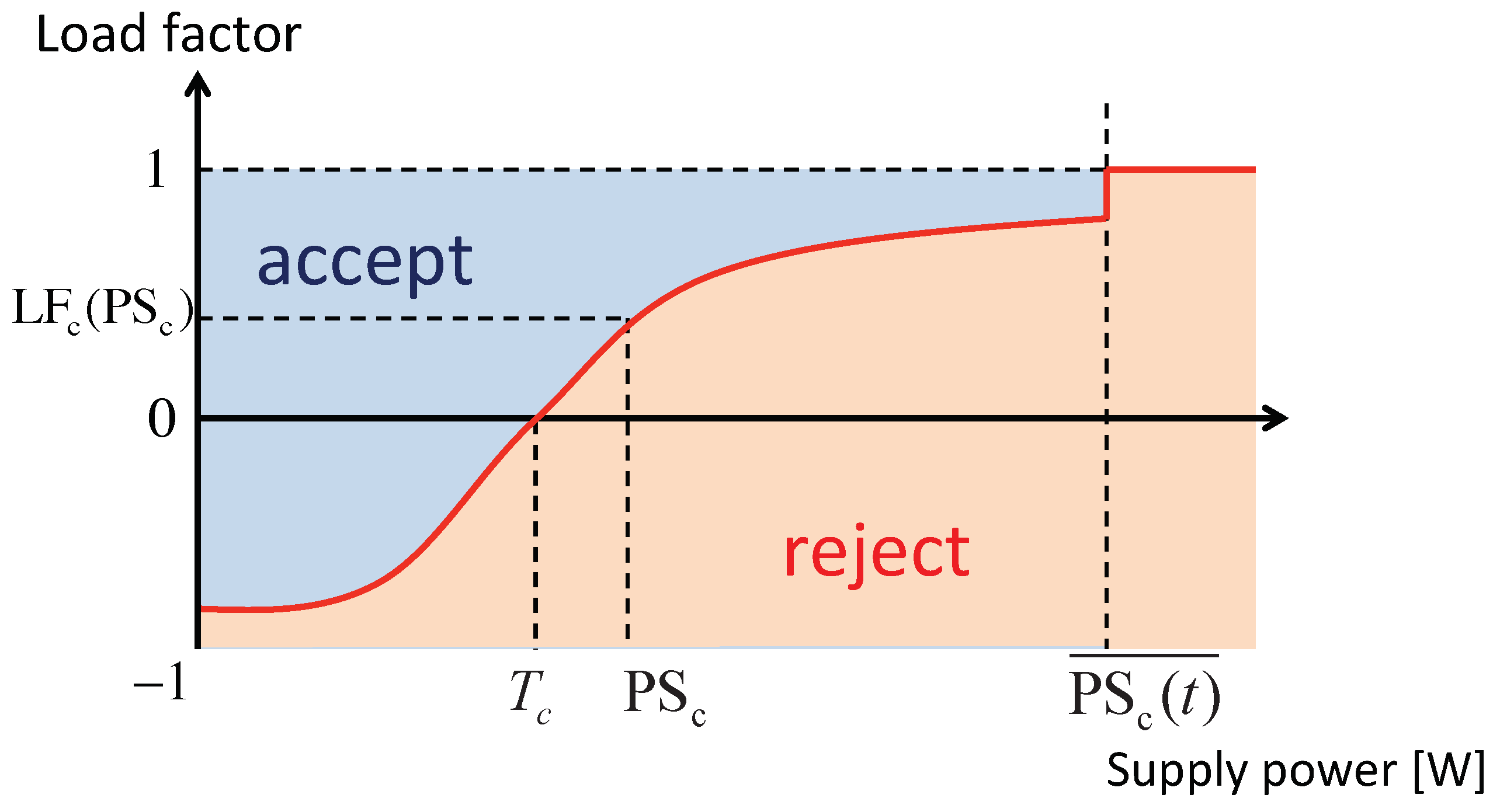
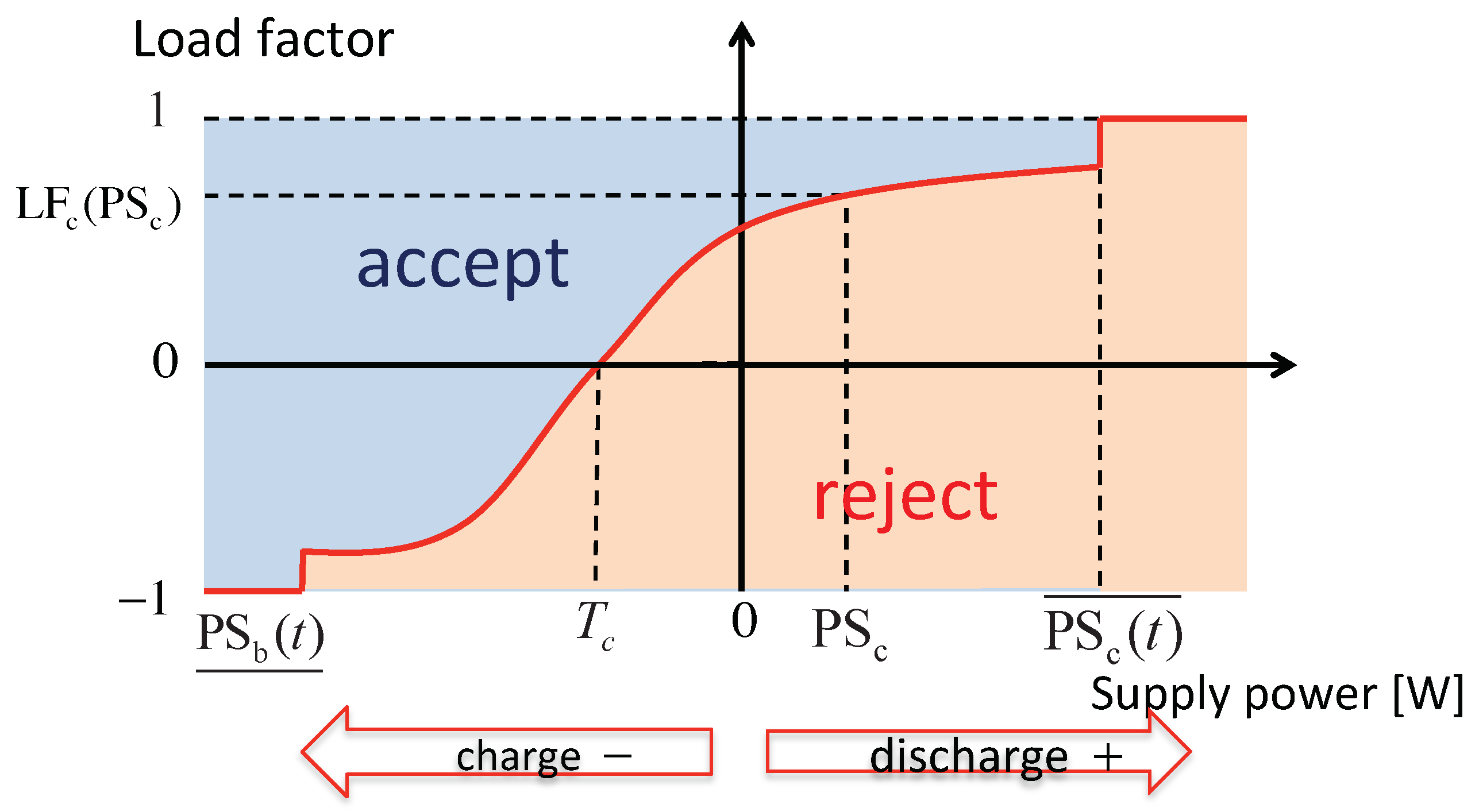

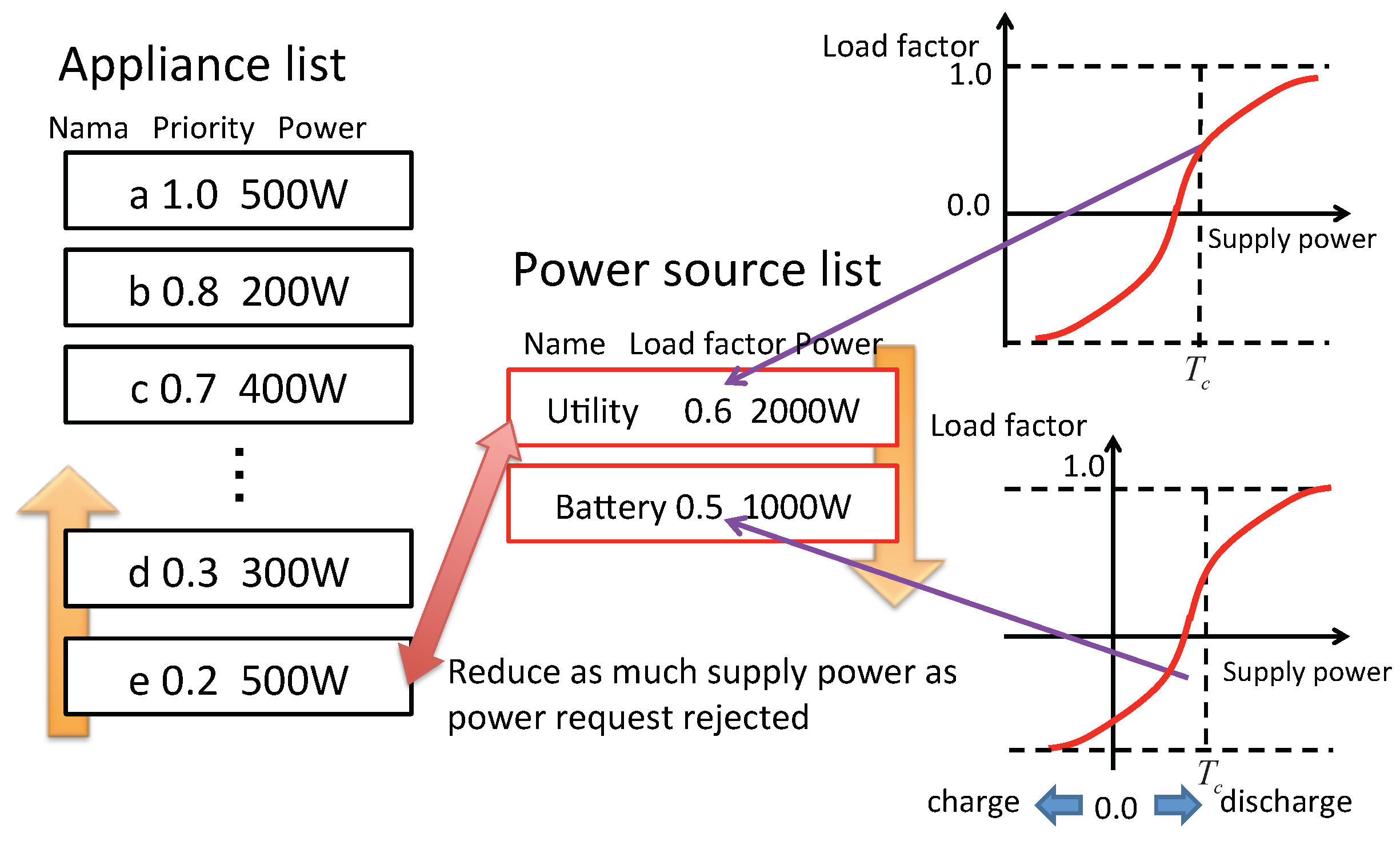
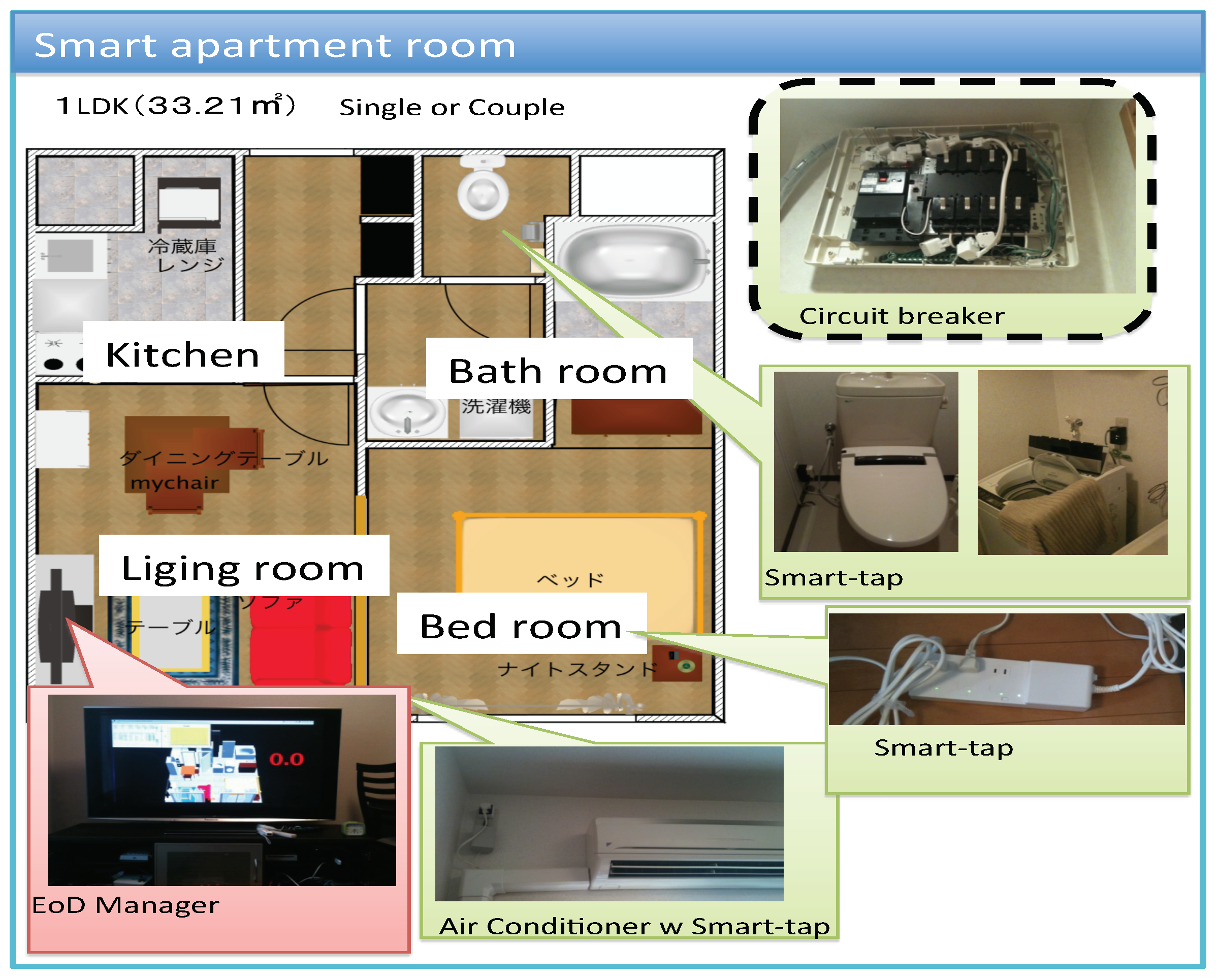
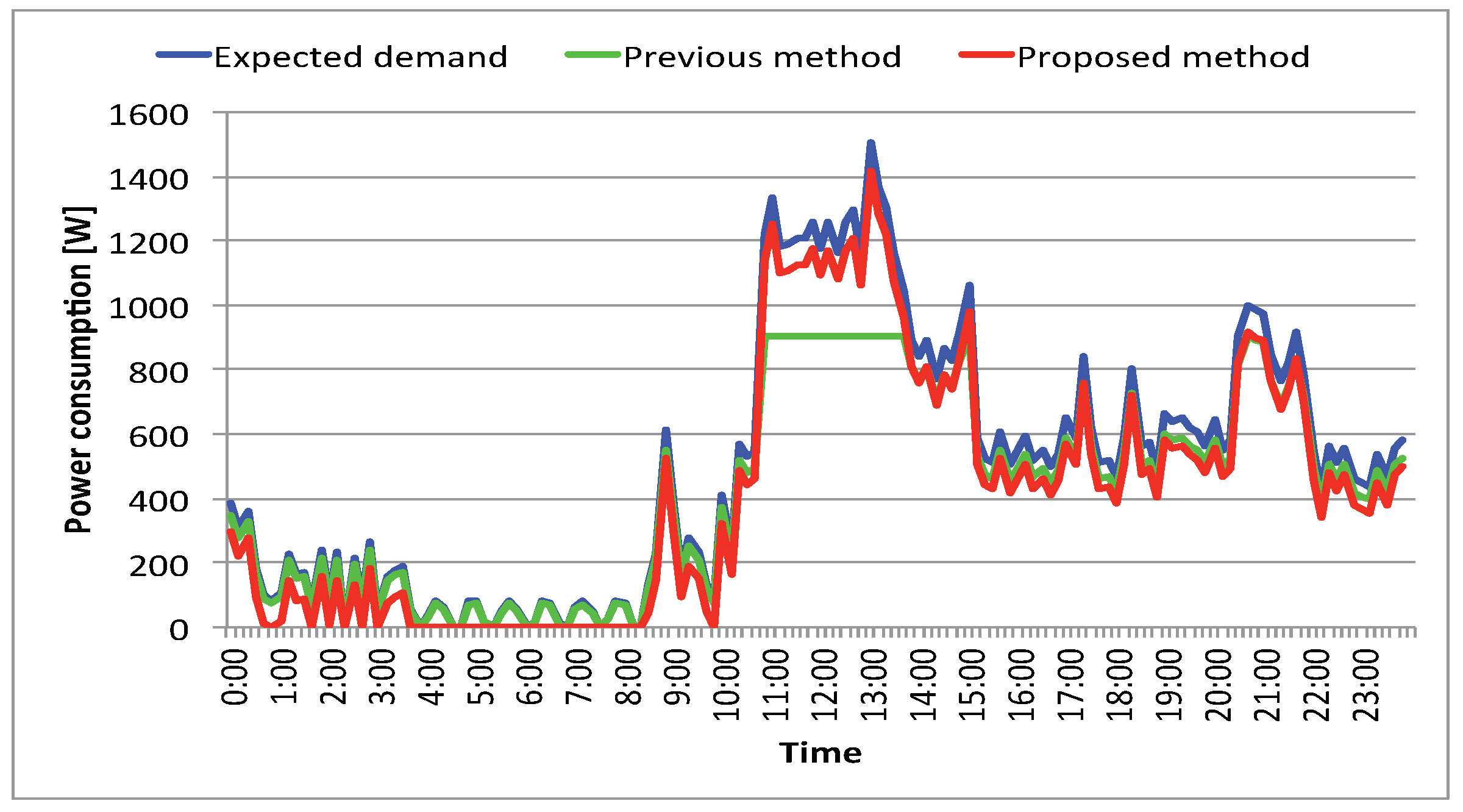
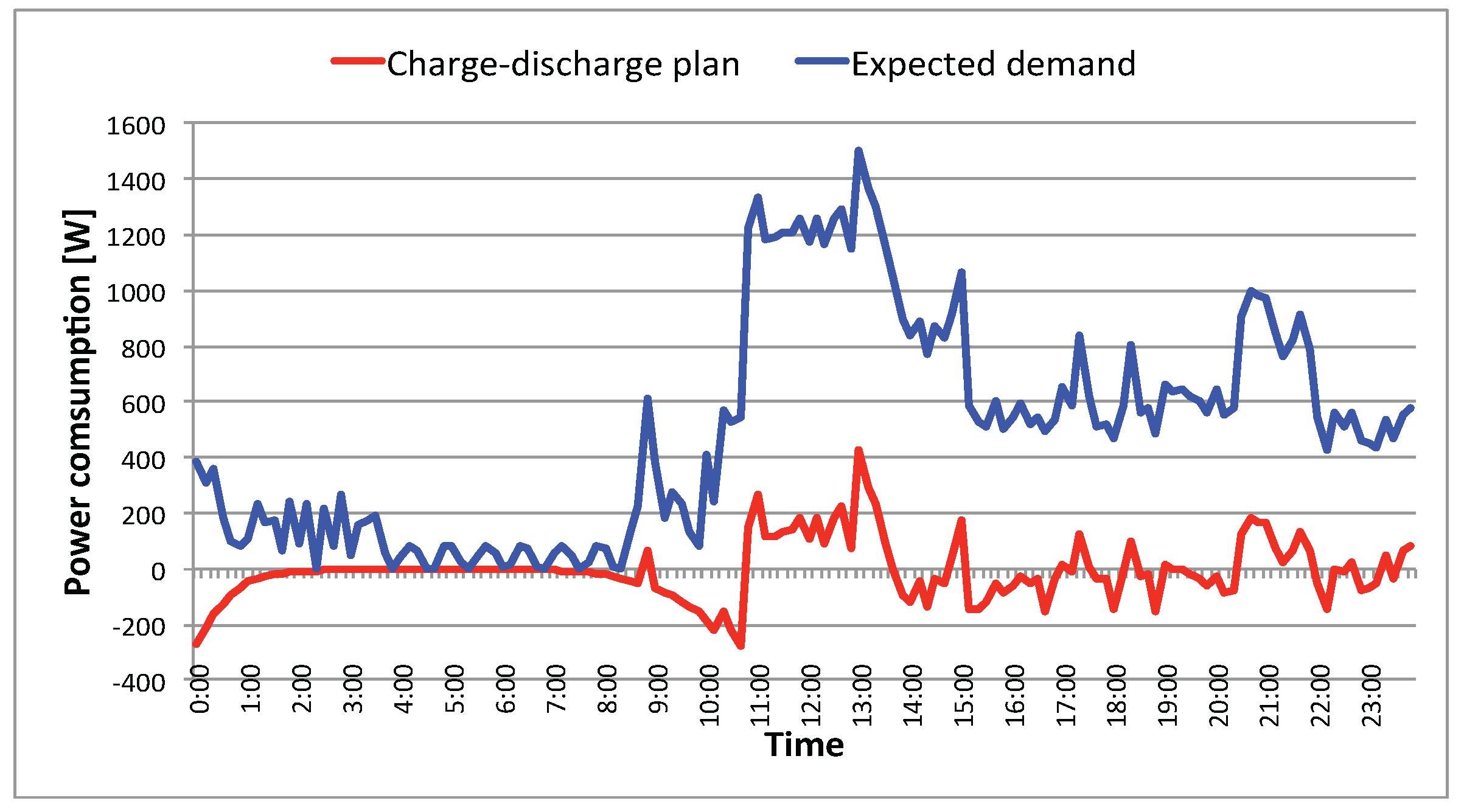
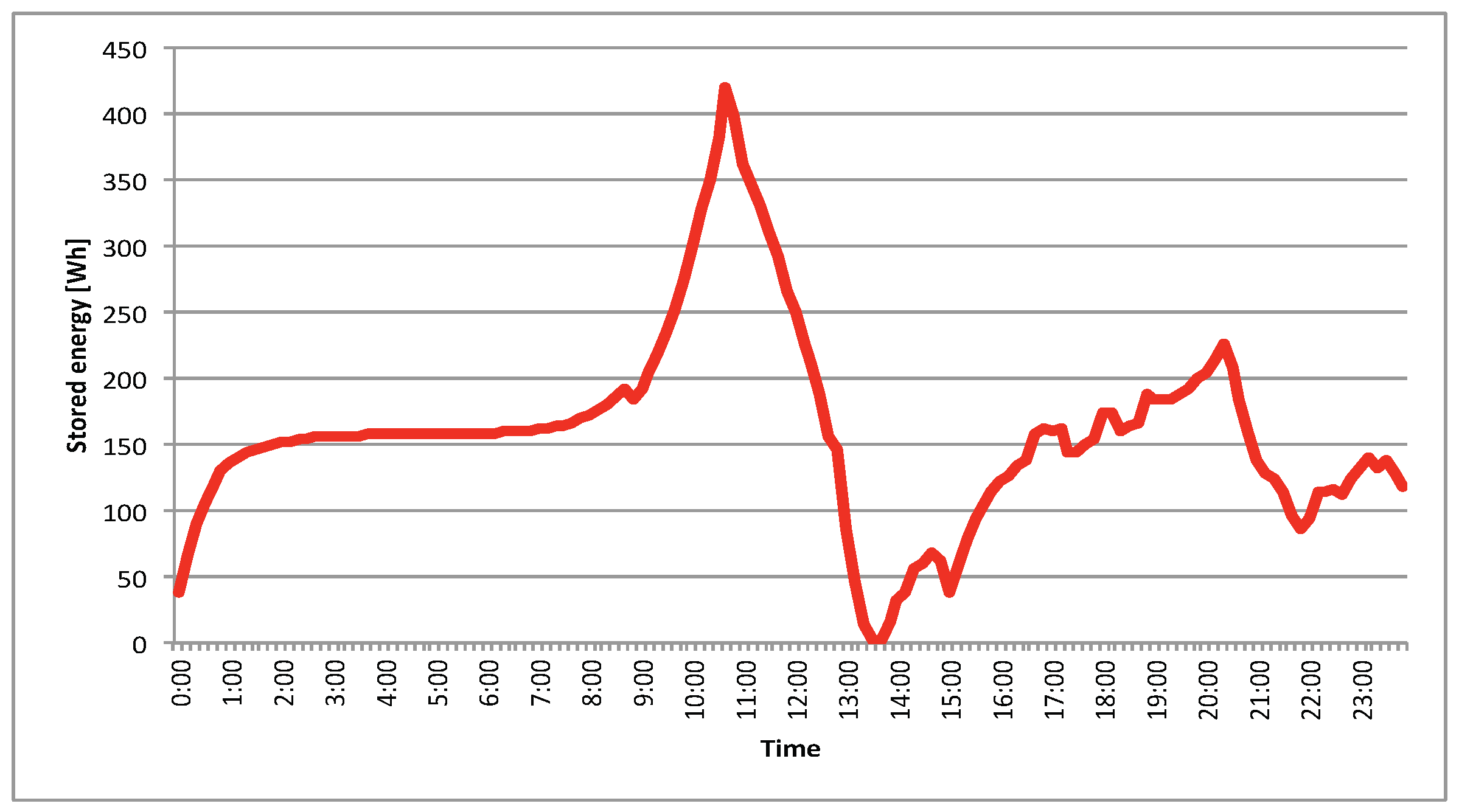
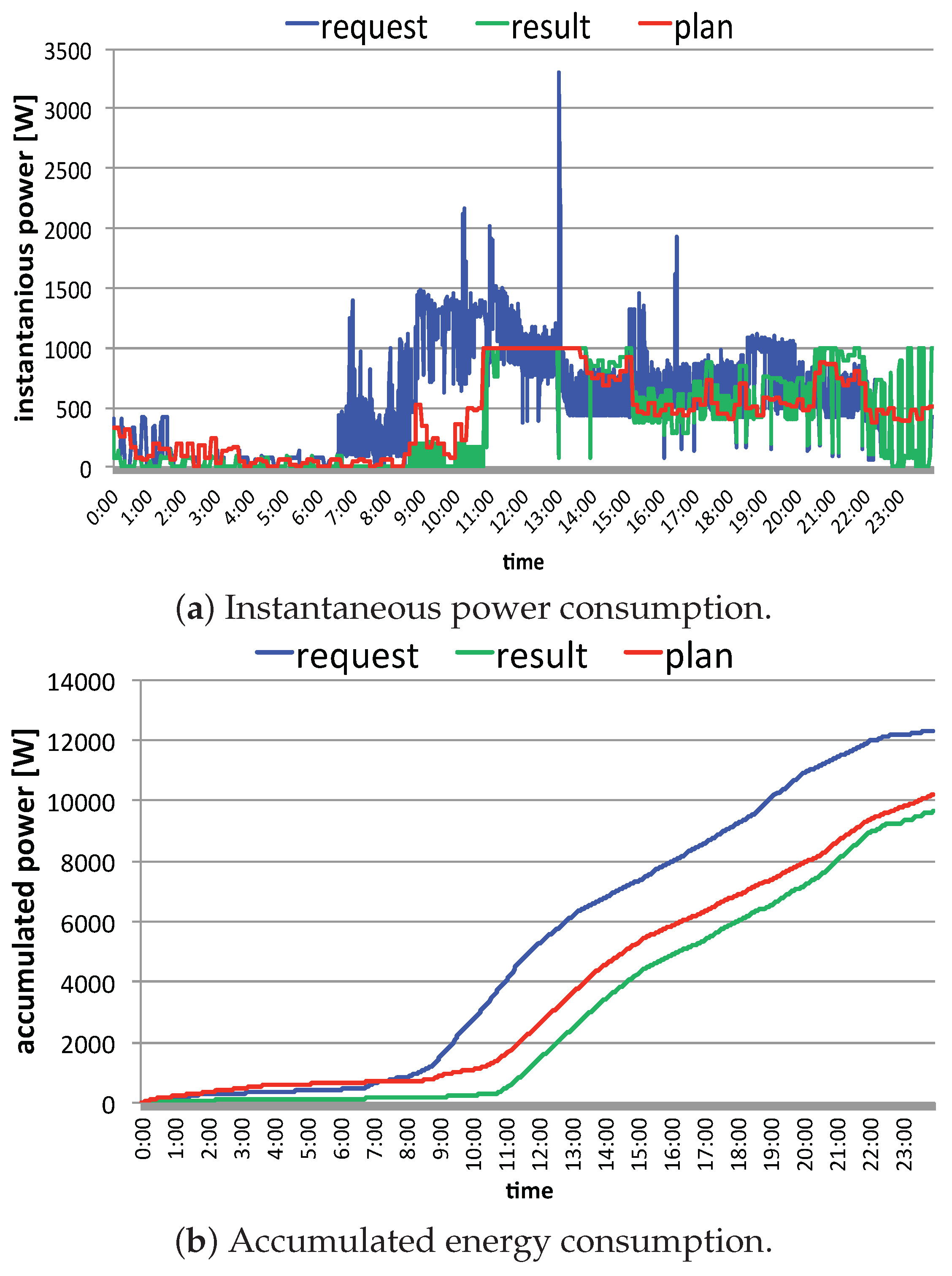
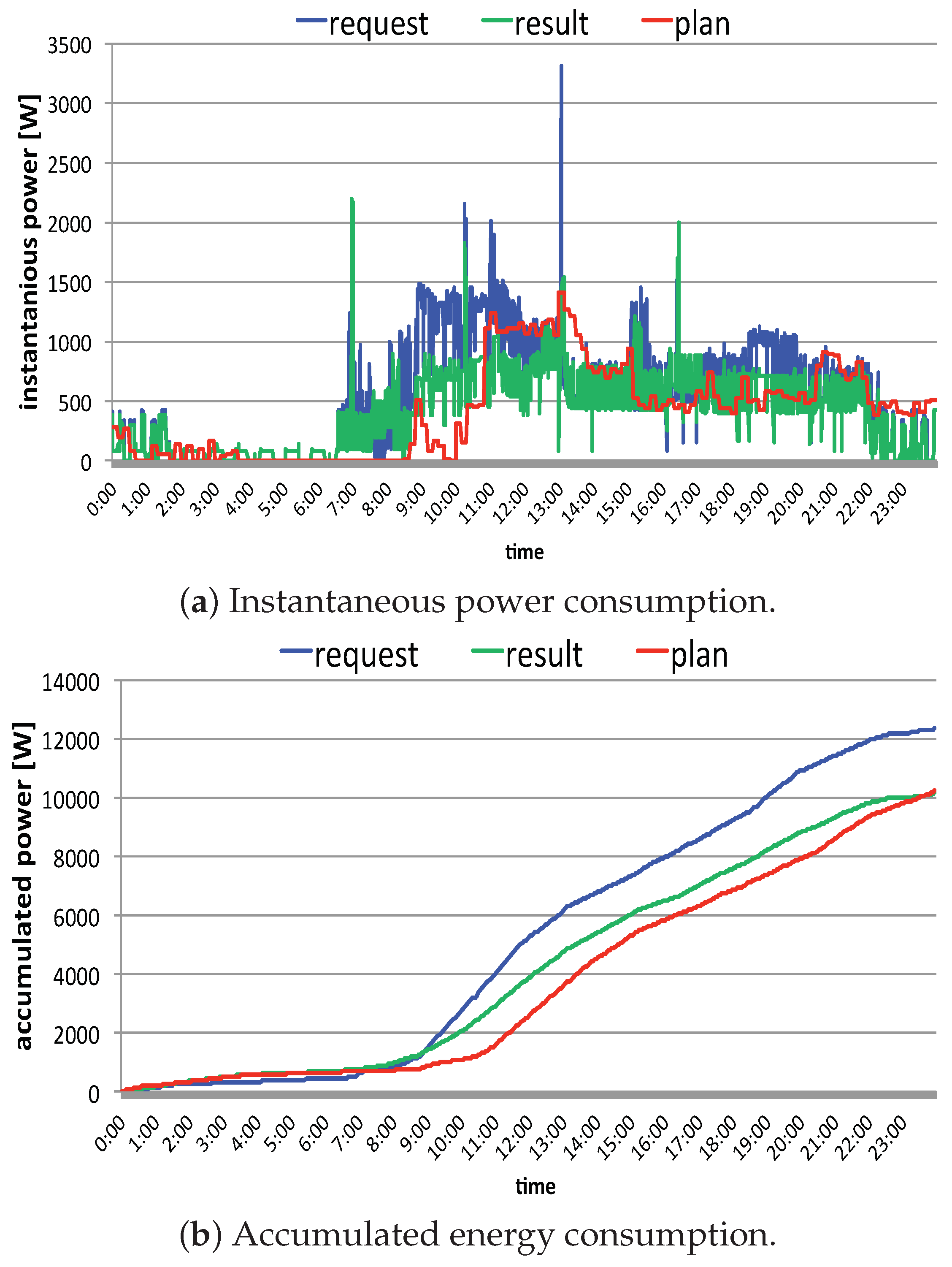
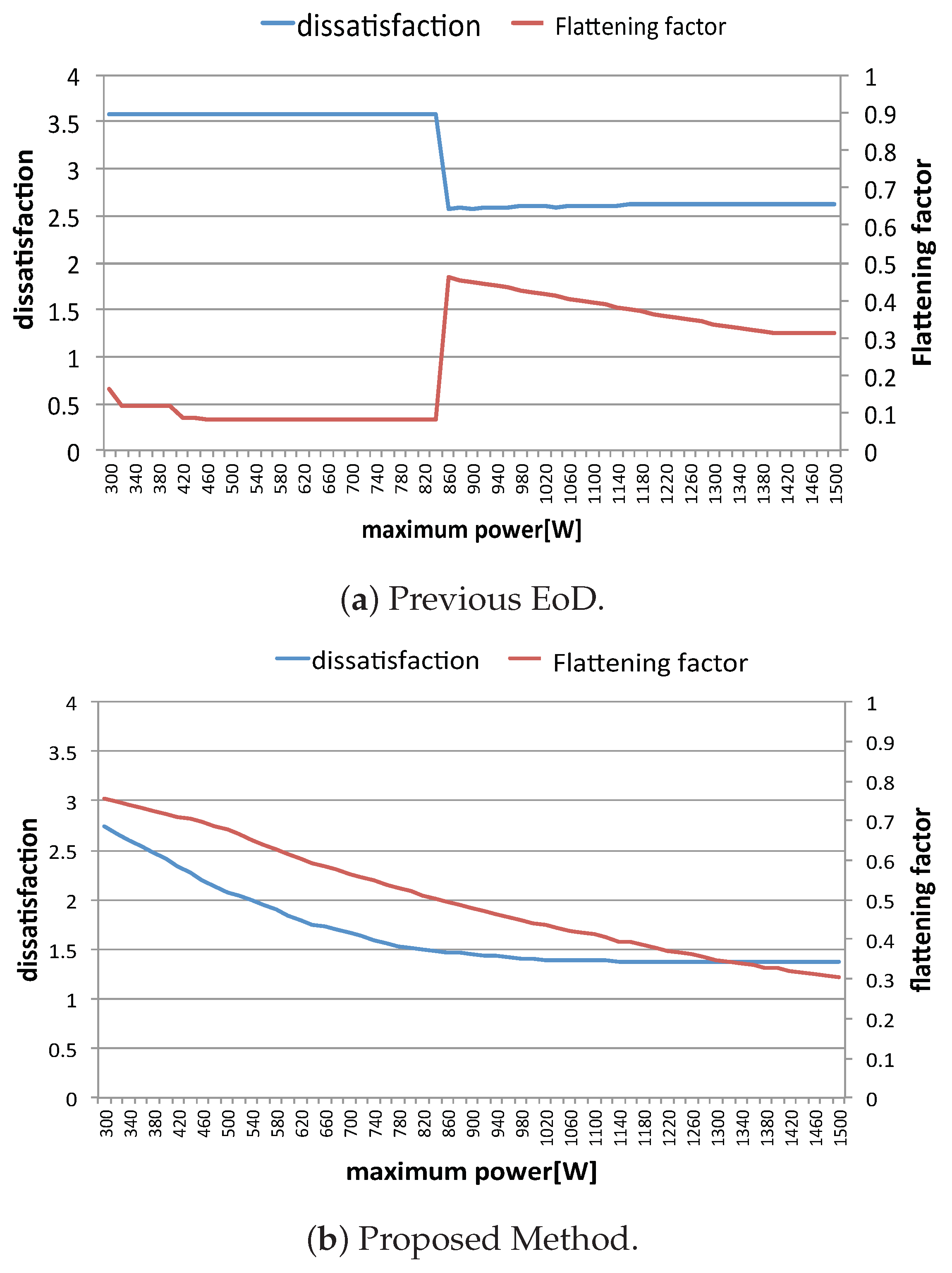
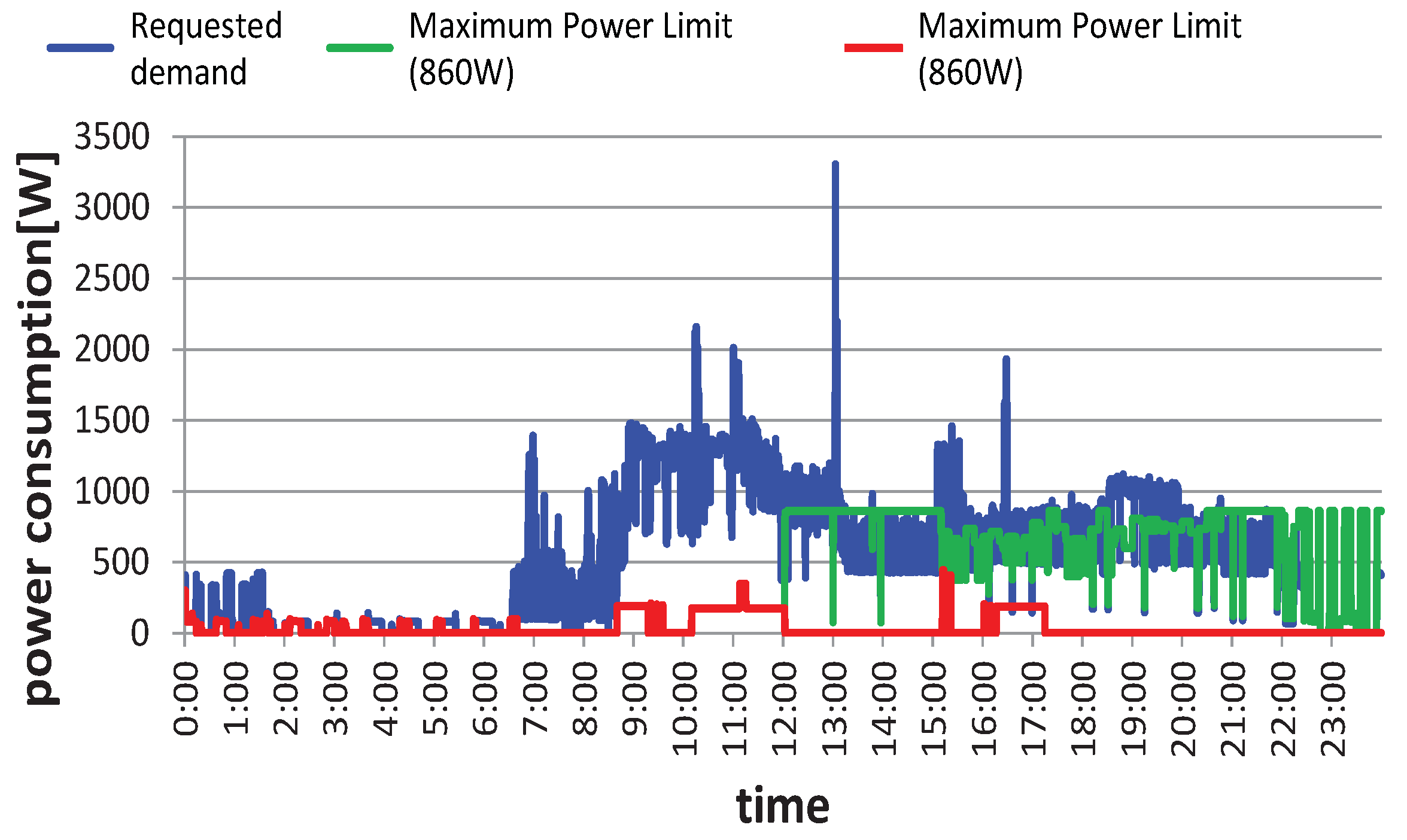

| Controllability | Appliances |
|---|---|
| Adjustable Time-shiftable Interruptible | pot |
| Adjustable Interruptible | air-conditioner, heater |
| Adjustable | lighting (living room, bedroom, kitchen, entrance, restroom, bathroom), TV (adjust brightness), electric carpet |
| Time-shiftable Interruptible | coffee maker |
| Interruptible | refrigerator |
| Time-shiftable | rice cooker, washing machine |
| Non-controllability (priority is fixed to 1.0) | DVD player, microwave oven, washlet, IH cooking heater |
Publisher’s Note: MDPI stays neutral with regard to jurisdictional claims in published maps and institutional affiliations. |
© 2022 by the authors. Licensee MDPI, Basel, Switzerland. This article is an open access article distributed under the terms and conditions of the Creative Commons Attribution (CC BY) license (https://creativecommons.org/licenses/by/4.0/).
Share and Cite
Javaid, S.; Kato, T. Adaptive Control of Energy Storage Systems for Real-Time Power Mediation Based on Energy on Demand System. Designs 2022, 6, 97. https://doi.org/10.3390/designs6050097
Javaid S, Kato T. Adaptive Control of Energy Storage Systems for Real-Time Power Mediation Based on Energy on Demand System. Designs. 2022; 6(5):97. https://doi.org/10.3390/designs6050097
Chicago/Turabian StyleJavaid, Saher, and Takekazu Kato. 2022. "Adaptive Control of Energy Storage Systems for Real-Time Power Mediation Based on Energy on Demand System" Designs 6, no. 5: 97. https://doi.org/10.3390/designs6050097





